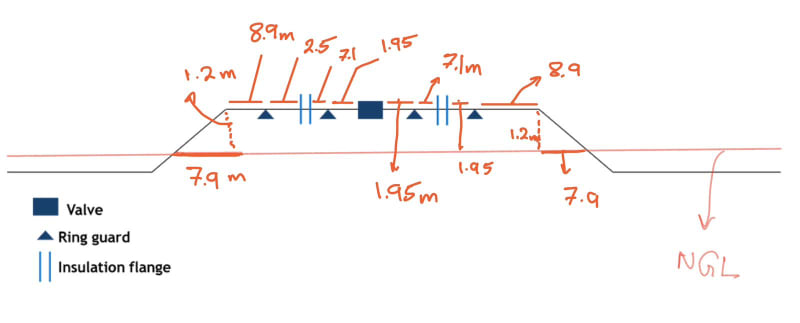GleeGloomGear
Mechanical
I'm currently facing a challenging situation with a new pipeline project involving a valve station where we need to replace a gasket. Despite loosening all flange bolts, we have not been able to achieve the required gap for a proper gasket replacement.
Project Overview:
The valve station's design necessitates a specific gap for gasket replacement. To address this, we've excavated approximately 50 meters around the area to create sufficient working space and facilitate the process.
Current Equipment and Setup:
Lifting Equipment: We have employed a sideboom to lift the pipe. However, it appears that a single sideboom does not provide sufficient lift to achieve the necessary gap.
Flange Spreaders: We are equipped with 7 flange spreaders, each with a capacity of 14 tons, but even these powerful tools have not sufficed to open the flange to the required extent.
Challenges Encountered:
Insufficient Lift: The primary issue is the inadequate lift from the sideboom, which is critical for achieving the required separation at the flange.
Flange Rigidity: Despite the high capacity of our flange spreaders, the rigidity of the flange assembly under the existing conditions has proven to be a significant barrier.
Seeking Expert Advice and Suggestions:
I am reaching out to this knowledgeable community for insights or recommendations on how to successfully navigate this issue. Here are some specific questions:
Additional Lifting Strategies: Would the addition of another sideboom or alternative lifting equipment help in achieving the required separation? If so, what specific equipment would you recommend?
Enhanced Flange Spreading Techniques: Are there more effective techniques or tools for spreading the flange that might offer a better result than our current approach?
Experience with Similar Challenges: Has anyone encountered a similar situation and found innovative solutions or adjustments that proved effective?
Your expertise and any suggestions you could offer would be greatly appreciated as we strive to overcome these obstacles. Collaborative insights can often lead to innovative solutions, and I am hopeful that with your support, we can resolve this issue efficiently.
Thank you for your time and assistance.
Project Overview:
The valve station's design necessitates a specific gap for gasket replacement. To address this, we've excavated approximately 50 meters around the area to create sufficient working space and facilitate the process.
Current Equipment and Setup:
Lifting Equipment: We have employed a sideboom to lift the pipe. However, it appears that a single sideboom does not provide sufficient lift to achieve the necessary gap.
Flange Spreaders: We are equipped with 7 flange spreaders, each with a capacity of 14 tons, but even these powerful tools have not sufficed to open the flange to the required extent.
Challenges Encountered:
Insufficient Lift: The primary issue is the inadequate lift from the sideboom, which is critical for achieving the required separation at the flange.
Flange Rigidity: Despite the high capacity of our flange spreaders, the rigidity of the flange assembly under the existing conditions has proven to be a significant barrier.
Seeking Expert Advice and Suggestions:
I am reaching out to this knowledgeable community for insights or recommendations on how to successfully navigate this issue. Here are some specific questions:
Additional Lifting Strategies: Would the addition of another sideboom or alternative lifting equipment help in achieving the required separation? If so, what specific equipment would you recommend?
Enhanced Flange Spreading Techniques: Are there more effective techniques or tools for spreading the flange that might offer a better result than our current approach?
Experience with Similar Challenges: Has anyone encountered a similar situation and found innovative solutions or adjustments that proved effective?
Your expertise and any suggestions you could offer would be greatly appreciated as we strive to overcome these obstacles. Collaborative insights can often lead to innovative solutions, and I am hopeful that with your support, we can resolve this issue efficiently.
Thank you for your time and assistance.


![[cook] [cook] [cook]](/data/assets/smilies/cook.gif)